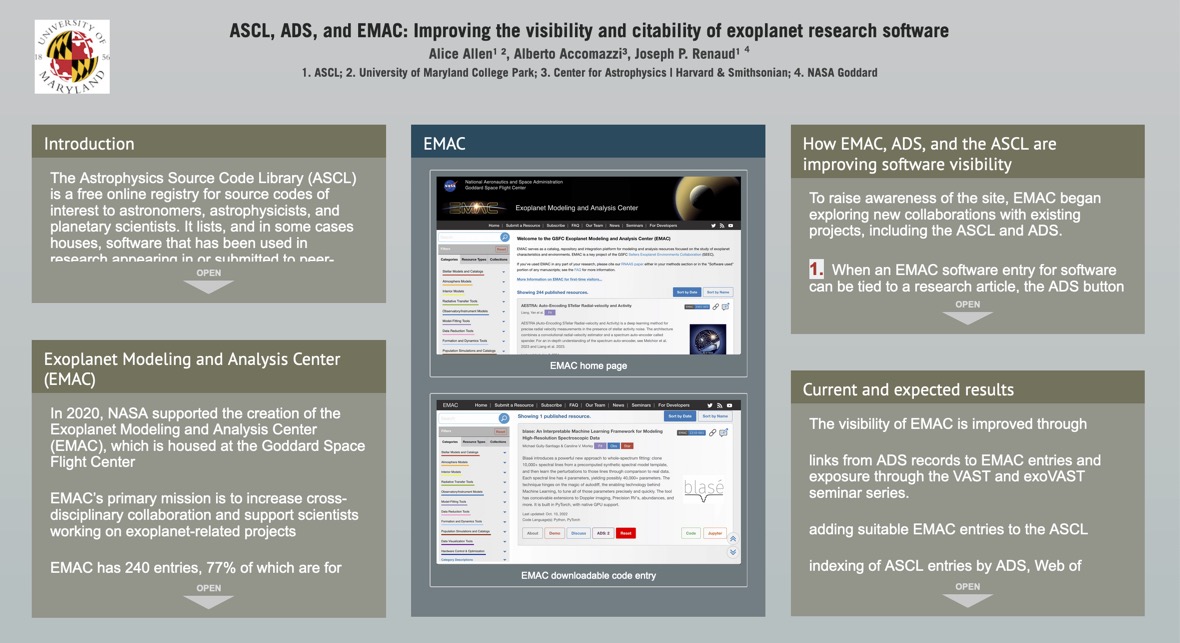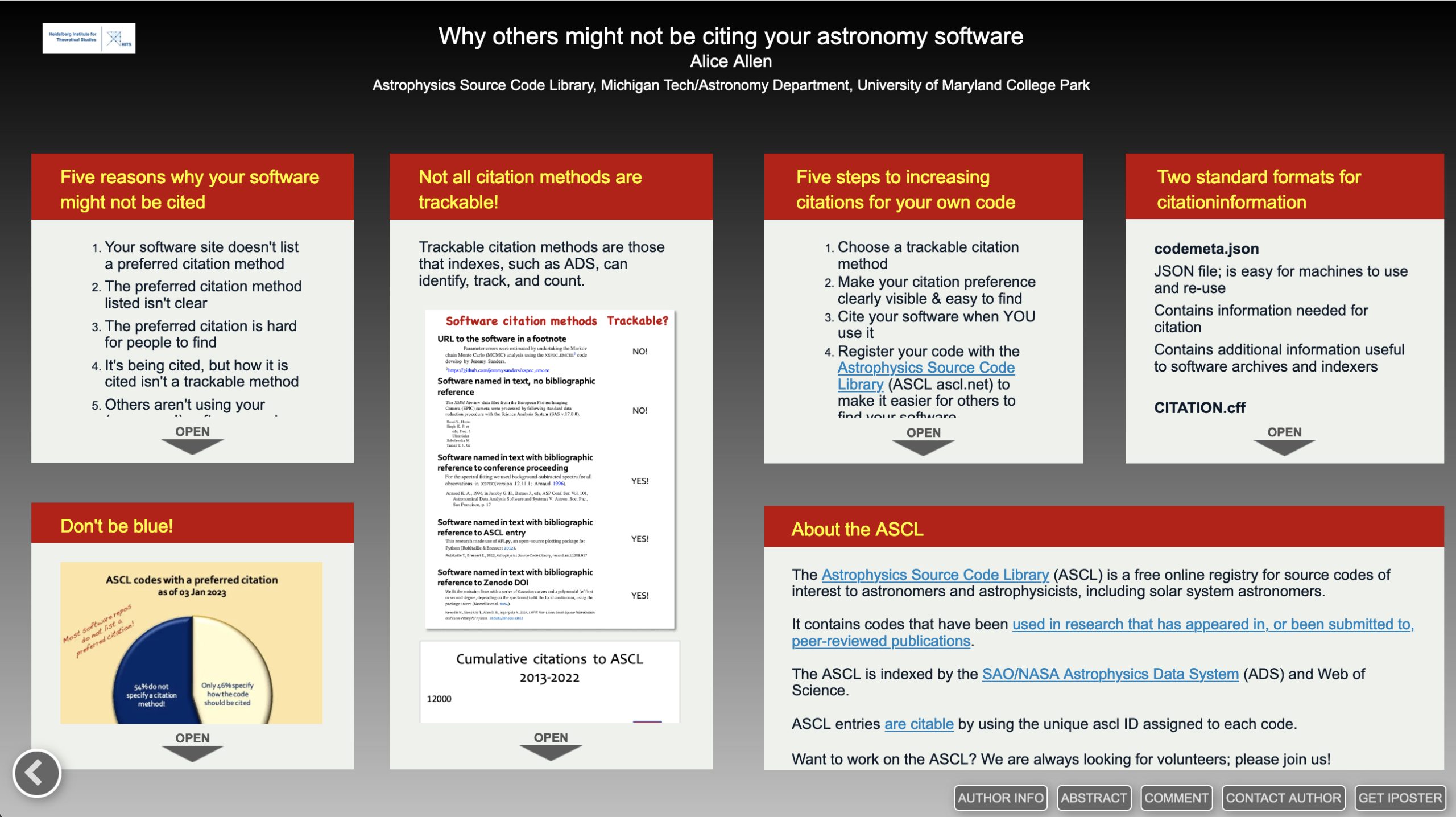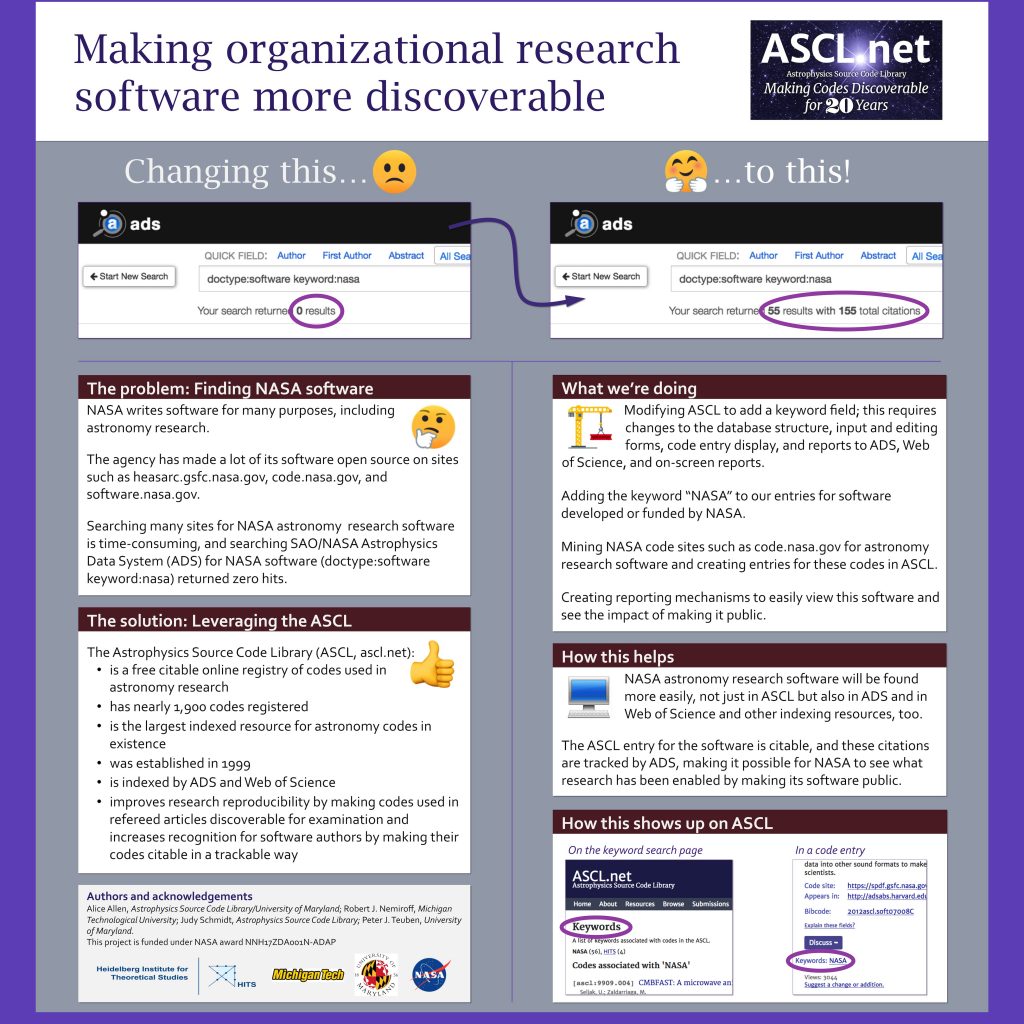Software is a vital part of astronomy research, and many software projects are available for anyone to use. The Virtual Astronomy Software Talks (VAST) seminar series provides a way for developers to share information about their software with the community. Using Zoom, one-hour VAST seminars are presented monthly and typically feature two software projects and include a discussion period to foster meaningful communication within the community. Other topics focused on software also also offered; past presentations have covered topics such as teaching computational astrophysics, building a coding community, and publishing software. Presentations are recorded and posted to the VAST YouTube channel, which now features over 20 previous seminars. This presentation covers how VAST is run, its growth in its second year, and its ExoVAST spinoff, and includes information on how to access VAST seminars and propose future talks.
Category Archives: AAS
The ASCL at AAS 243: A Special Session and posters!
The ASCL is at the 243rd meeting of the American Astronomical Society (AAS), which is taking place in the major food destination New Orleans. In addition to tracking down beignets and bread pudding, ASCL team members have shared the stage with others in a Special Session and have presented iPosters. The Special Session was held on Monday afternoon; iPosters were presented on Monday and Tuesday evenings.
~~~~~
Special Session: Into the Future: Building on 25 Years of Community Organization in Astro Software Development
Abstract: Over the past 25 years, astronomy has seen many changes involving research software development. These include improved transparency, improved software availability, and changes in journal policies. Formal recognition of community-based software development has increased through targeted funding, the establishment of new journals specifically focused on software, and code citation.
Changes in astro software development include the rise of open social coding sites such as GitHub and GitLab, the establishment and growth of conferences devoted to or including research software (such as ADASS, FORCE11, and the Research Data Alliance), and community-based training in software development (for example, The Carpentries and SciCoder) and exploration (for example, .dotastro and hack days) events.
This Special Session will look back at the community-driven work that has enabled some of these changes and look forward to future horizons for the software community in astronomy. Leaders of some of these community efforts will serve on an expert panel and will share their perspectives, after which the floor will be open for discussion with participants.
Speakers
Peter Teuben, University of Maryland, College Park: Introduction and Overview
Demitri Muna, Chief Science Data Office, NASA HQ: Software Training for Research Scientists: SciCoder and Other Efforts
Aarya Patil, Max Planck Institute for Astronomy: Building the AstroPy Community
Robert Nemiroff, Michigan Technological University: How and Why the Astrophysics Source Code Library Was Formed
Kimberly DuPrie, Space Telescope Science Institute: Lessons from Industry
~~~~~
iPoster: Using the Astrophysics Source Code Library in the classroom
Alice Allen, Astrophysics Source Code Library; Kimberly DuPrie, Space Telescope Science Institute; Peter Teuben, University of Maryland, College Park; Robert Nemiroff, Michigan Technological University
Abstract: The Astrophysics Source Code Library (ASCL, ascl.net) is an online registry of source codes used in refereed astrophysics research. It currently lists over 3,300 codes and covers all aspects of computational astrophysics, and all of its public metadata about software can be downloaded. This presentation covers possible ways the ASCL can be used by educators and their graduate students. The ASCL serves as a discovery tool for codes that can be used for one’s own research. Graduate students can also investigate existing codes to see how common astronomical problems are approached numerically in practice, and use these codes as benchmarks for their own solutions to these problems. Further, they can deepen their knowledge of software practices and techniques through examination of others’ codes, and can use the ASCL’s data set for research on computational methods in astrophysics.
~~~~~
iPoster: ASCL, ADS, and EMAC: Improving the visibility and citability of exoplanet research software
Alice Allen, Astrophysics Source Code Library; Alberto Accomazzi, Center for Astrophysics | Harvard & Smithsonian; Joe Renaud, UMD College Park / NASA Goddard.
Abstract: The Astrophysics Source Code Library (ASCL, ascl.net) is a free online registry for source codes of interest to astronomers, astrophysicists, and planetary scientists. It lists, and in some cases houses, software used in research that has appeared in, or been submitted to, peer-reviewed publications. It now has over 3300 software entries and is indexed by ADS and Clarivate’s Web of Science. In 2020, NASA created the Exoplanet Modeling and Analysis Center (EMAC, emac.gsfc.nasa.gov). Housed at the Goddard Space Flight Center, EMAC serves, in part, as a catalog and repository for exoplanet research resources. EMAC currently has 223 entries, 77% of which are for downloadable software. This presentation will cover the collaborative work the ASCL is doing with EMAC and with NASA’s Astrophysics Data System (ADS) to increase the discoverability and citability of EMAC’s software entries and to strengthen the ASCL’s and ADS’s ability to serve the planetary science community.
ASCL poster on software citation at AAS 241
All posters at the 241st meeting of the American Astronomical Society were iPosters: displayed on a screen instead of printed on paper or fabric. The ASCL’s iPoster is available for viewing in the iPoster Gallery; the image below is a static screenshot.
Why others might not be citing your astronomy software
Your codes can themselves be cited, and you can choose your preferred citation method! So why aren’t people citing your code? Come find out, and also learn what five steps you can take to improve citation of the software you write.
In the past decade, software citation has accelerated in astrophysics, resulting in the field now having multiple ways to cite computational methods. Adding software metadata files, such as a CITATION.cff or a codemeta.json file, to the root directory of a GitHub repo (or other code storage site) lets others know how they should cite that software. Yet most software authors do not specify how they would like their code to be cited, while others specify a citation method that is not easily tracked (or tracked at all) by most indexers. In 2020, the Astrophysics Source Code Library (ASCL, ascl.net) sent authors of 135 codes software metadata files (CITATION.cff and codemeta.json), tailored to each computational method, and suggested that one of these files be edited as needed and included on their code site. In early 2021, we examined the code sites for these 135 entries and found that only 41% of these sites had citation information in any form available. In mid-2021, GitHub announced the integration of CITATION.cff into its service, making it easier to add this metadata file to one’s repo. Even so, as of January, 2023, 54% of the codes registered in the ASCL do not specify how to cite use of the software. The lack of citation information creates an obstacle for article authors to provide credit to software creators, thus hindering citation of and recognition for computational contributions to research and for the scientists who develop and maintain software.
#AAS241
The ASCL at the 237th meeting of the American Astronomical Society
It’s that time of year again, when astronomers’ hearts and wings turn to AAS for the winter AAS meeting. This year, however, the wings are virtual; like other conferences in this time of pandemic, the 237th meeting of the AAS is online. I’m very impressed with the online meeting space, which includes a conference center with different locations to visit, a virtual exhibit hall, an iPoster gallery, and many opportunities through Slack and thoughtfully-planned activities to enable and encourage interaction between attendees, exhibitors, and presenters, including the always great Open Mic event, a highlight of the winter meeting, on Wednesday evening.
Members of the ASCL are presenting two iPosters + (the “plus” is a short Zoom session about the poster) and an oral presentation at this meeting.
On Monday, Siddha Mavuram, an UMD student hired to do development work for the ASCL for our NASA ADAP project, is doing an iPoster + presentation titled Come search the ASCL with our new API! I also have an iPoster + presentation on Monday called Life, the Universe and Everything… you ever wanted to know about the Astrophysics Source Code Library. Though our short talks, using our posters only as our visual aids, are on Monday, our posters are available all week.
On Tuesday, Peter Teuben is presenting results of our NASA ADAP project. Though Siddha is presenting part of the development work done for this project, Peter is sharing the overall results in his oral presentation Increasing the visibility of NASA astrophysics software through the ASCL, showing how this project has made it possible to search the ASCL and ADS for NASA software through the use of keywords and, on ADS, the doctype value software. You can see these results yourself on the ASCL and with an ADS search.
Because I very cleverly failed to realize that all the links I added to the slides for my iPoster wouldn’t work once I made those slides images (doh!), I provide a PDF of these slides for download below in which most, but alas not all, of the links work. Later this week, I’ll provide a full list of links in another post that will contain all of the resources and links the ASCL is presenting this week.
ASCL poster at AAS235
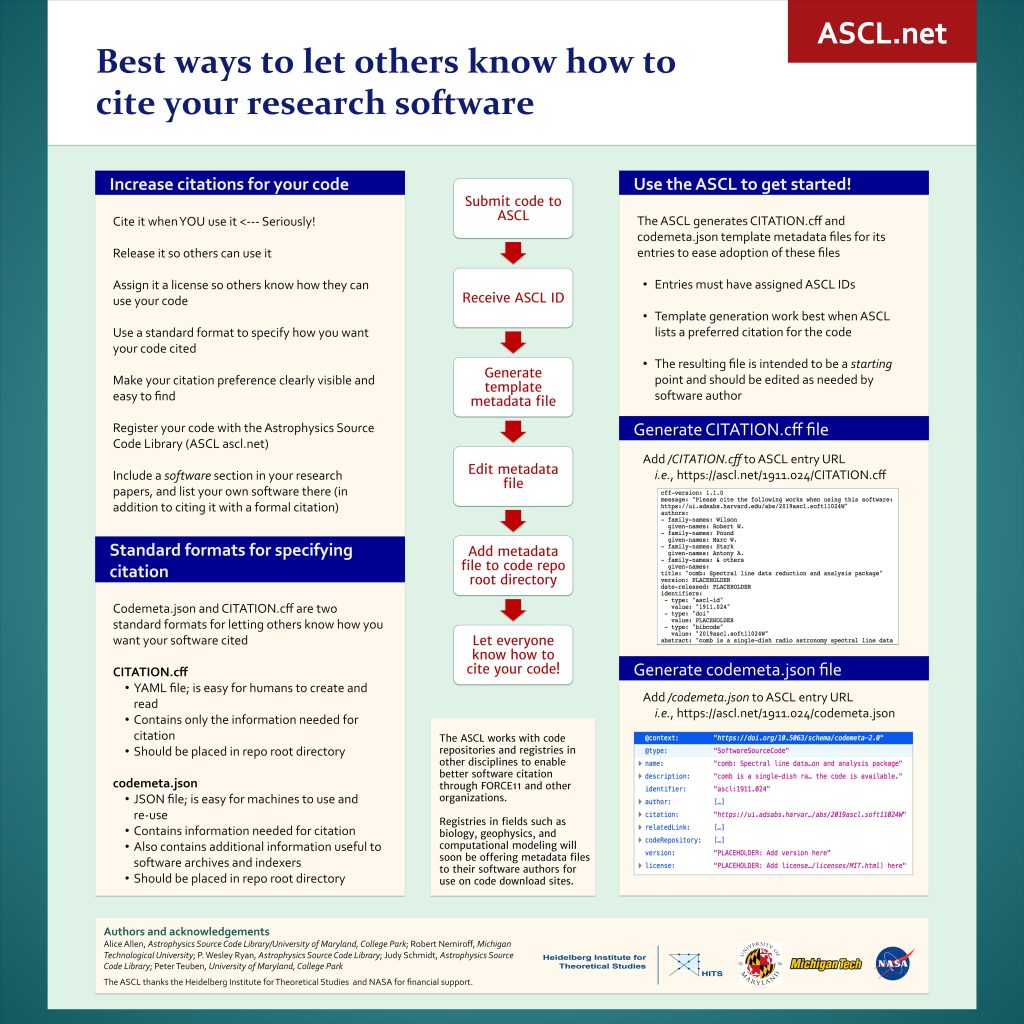
Abstract: Software citation is good for research transparency and reproducibility, and maybe, if you work it right, for your CV, too. You can get credit and recognition through citations for your code! This presentation highlights several powerful methods for increasing the probability that use of your research software will be cited, and cited correctly. The presentation covers how to create codemeta.json and CITATION.cff automagically from Astrophysics Source Code Library (ASCL ascl.net) entries, edit, and use these files, the value of including such files on your code site(s), and efforts underway in astronomy and other fields to improve software citation and credit.
Authors: A. Allen1,2, R. Nemiroff3, P. Ryan1, J. Schmidt1, P. Teuben2
1Astrophysics Source Code Library
2Astronomy Department, University of Maryland, College Park, MD
3Michigan Technological University, Houghton, MI
Download (PDF)
The ASCL at AAS 235
The ASCL is participating in the American Astronomical Society (AAS) meeting that started yesterday in Honolulu, Hawai’i. We have two events, both on Sunday, January 5:
Best ways to let others know how to cite your research software
January 5; Poster 109.12
Software citation is good for research transparency and reproducibility, and maybe, if you work it right, for your CV, too. You can get credit and recognition through citations for your code! This presentation highlights several powerful methods for increasing the probability that use of your research software will be cited, and cited correctly. The presentation covers how to create codemeta.json and CITATION.cff automagically from Astrophysics Source Code Library (ASCL ascl.net) entries, edit, and use these files, the value of including such files on your code site(s), and efforts underway in astronomy and other fields to improve software citation and credit.
The Future and Future Governance of the Astrophysics Source Code Library
January 5, 2:00 PM – 3:30 PM; HCC – Room 301B
Over the past ten years, the Astrophysics Source Code Library (ASCL, ascl.net) has grown from a small repository holding about 40 codes with hand-coded HTML pages maintained by one person to a resource with citable entries on over 2000 codes with a modern database structure that is user- and editor-friendly maintained by a small group of volunteers. With its 20th anniversary now behind it, it’s time to look at the resource and its governance and management. Does its current structure best serve the astro community? What changes would you like to see to its governance? We don’t know the answers to these and other questions! Please join us for an open discussion on the resource and what a new governance model for the ASCL might be.
Research poster at AAS 233
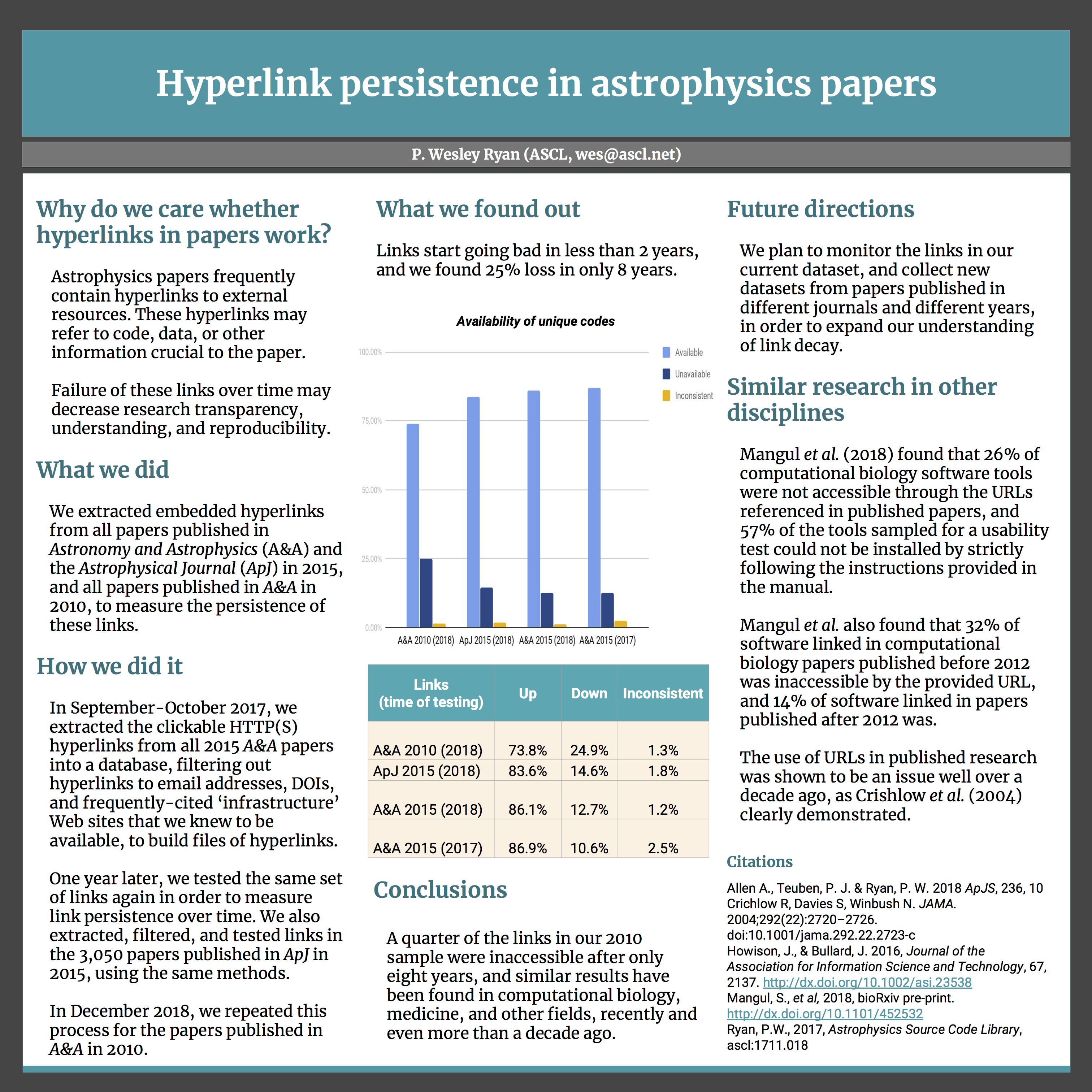 URLs have often been used as proxy citations for software and data. We extracted URLs from one journal’s 2015 research articles, removed those from certain long-term reliable domains, and tested the remainder to determine what percentage of these URLs were accessible in September and October 2017. We repeated this test a year later to determine what percentage of these links were still accessible. We will present what we learned about URL accessibility in astronomy.
URLs have often been used as proxy citations for software and data. We extracted URLs from one journal’s 2015 research articles, removed those from certain long-term reliable domains, and tested the remainder to determine what percentage of these URLs were accessible in September and October 2017. We repeated this test a year later to determine what percentage of these links were still accessible. We will present what we learned about URL accessibility in astronomy.
P. Wesley Ryan, Astrophysics Source Code Library
ASCL poster at AAS #233
Software is the most used instrument in astronomy, and organizations such as NASA and the Heidelberg Institute for Theoretical Physics (HITS) fund, develop, and release research software. NASA, for example, has created sites such as code.nasa.gov and software.nasa.gov to share its software with the world, but how easy is it to see what NASA has? Until recently, searching NASA’s Astrophysics Data System (ADS) for NASA’s astronomy software has not been fruitful; NASA has funded the Astrophysics Source Code Library (ASCL ascl.net) to improve the discoverability of these codes. The ASCL, now celebrating its 20th anniversary, is a free online registry of software used in astronomy research and is indexed by ADS, Web of Science, and other resources. Adding NASA and HITS astronomy research codes to the ASCL with appropriate tags enables finding this software easily not only in the ASCL but also in ADS and other services that index the ASCL. This poster presentation covers the changes the ASCL has made to enable discovery of NASA software in ADS and the results of this work.
Alice Allen, Astrophysics Source Code Library/University of Maryland, College Park
Peter Teuben, University of Maryland, College Park
Judy Schmidt, Astrophysics Source Code Library
Robert Nemiroff, Michigan Technological University
Software activities at AAS 233 in Seattle, Jan 2019
It’s that time of year again when software folks — users and authors alike — dream of all the software activities at the winter AAS meeting. So here is the ASCL’s (abbreviated*) annual round-up to jumpstart your dreams and warm your code-loving heart! If you have items you want added, please let me know in the comments below or send an email to editor@ascl.net. Thank you!
All rooms are in the Washington State Convention Center unless otherwise specified.
SATURDAY, 5 JANUARY 2019
Workshops
Introduction to Software Carpentry (Day 1), 9:00 AM – 5:00 PM; 211
The AAS Chandra/CIAO Workshop, 9:00 AM – 6:00 PM; 204
Using Python to Search NASA’s Astrophysics Archives, 10:00 AM – 11:30 AM; 213
SUNDAY, 6 JANUARY 2019
Workshops
SOFIA Workshop for FORCAST and HAWC+ Data Analysis, 8:30 AM – 5:15 PM; 201
Adding LISA to your Astronomy Tool Box, 9:00 AM – 5:00 PM; 213
Introduction to Software Carpentry (Day 2), 9:00 AM – 5:00 PM; 211
Using Python and Astropy for Astronomical Data Analysis, 9:00 AM – 5:00 PM; 4C-4
The AAS Chandra/CIAO Workshop, 9:00 AM – 6:00 PM; 204
Advanced Searching in the New ADS: On the Web and Using the API, 3:00 PM – 4:30 PM; 304
MONDAY, 7 JANUARY 2019
Splinter meetings
Data Science, 8:00 AM – 6:00 PM, 4C-1
Updates on Implementing Software Citation in Astronomy, 12:30 PM – 2:00 PM; 203
An Open Discussion on Astronomy Software, 2:00 PM – 3:30 PM; 4C-4
Open event
AAS WorldWide Telescope presents: Advances in Astronomical Visualization, 10:00 AM – 11:30 AM; 214
Oral presentations
Session 126. Machine Learning in Astronomical Data Analysis, 2:00 PM – 3:30 PM; 607 (5 presentations)
Also:
112.01. Constraining BH formation with 2M05215658+4359220, 10:00 AM – 10:10 AM, 612
109.03. Real-time data reduction pipeline and image analysis software for FIREBall-2: first flight with a δ-doped UV-EMCCDs operating in counting mode, 10:30 AM – 10:40 AM, 608
175.06. Python, Unix, Observing, and LaTeX: Introducing First Year Undergraduates to Astronomical Research, 10:50 AM – 11:00 AM, 620
109.08. TESS Data Analysis using the community-developed Lightkurve Python Package, 11:20 AM – 11:30 AM, 608
123.02D. A Uniform Analysis of Exoplanet Atmosphere Spectra Observed by HST WFC3 Is Consistent with Watery Worlds, 2:10 PM – 2:30 PM, 6C
129.06. Reconstructing the Orphan Stream Progenitor with MilkyWay@home Volunteer Computing, 3:00 PM – 3:10 PM, 611
Selected posters
144.25. Identifying and Comparing Centrally Star-Forming Galaxies Using MaNGA
144.29. Deriving star formation histories from photometric spectral energy distributions with diffusion k-means
144.30. Using Convolutional Neural Networks to predict Galaxy Metallicity from Three-Color Images
144.35. Automatic Detection and Analysis of Debris from Galactic Accretion Events
145.05. Galaxy Gradients Across Simulations
145.07. Reduction and Analysis of GMOS Spectroscopy for Herschel Sources in CANDELS
145.25. Comparison of the HI Signal Extraction Algorithms of SoFiA and ALFALFA
140.02. Tracking the TESS Pipeline
140.12. Undergraduates Can Find Planets Too
140.16. Identifying Transiting Exoplanets in with Deep Learning in K2 Data
140.20. The Impact of Small Statistics on Identifying Background False Positives in Kepler Data
140.23. AutoRegressive Planet Search for Ground-Based Transit Surveys
140.29. Getting to Know Your Star: A comparison of analytic techniques for deriving stellar parameters and abundances
149.18. NANOGrav: Data Accessibility, Analysis and Automation using Python
150.01. Revised Simulations of the Planetary Nebulae Luminosity Function
150.15. Identifying Binary Central Stars of Planetary Nebulae with PSF Fitting
158.02. HaloSat: X-Ray Calibration and Spectral Analysis for a NASA CubeSat
162.04. The Starchive
Selected iPosters
167.02. Modeling circumstellar dust around low-mass-loss rate carbon-rich AGB stars
167.04. The response of optical Fe II emission in AGNs to changes in the ionizing continuum, I: photoionization modelling
164.02. A Maximum Likelihood Approach to Extracting Photon-Starved Spectra of Directly Imaged Exoplanets
166.02. Smoothed Particle Inference Analysis of SNR DEM L71
171.03. The State of Software Tools for the Space Telescope Imaging Spectrograph
Other activities of possible interest
Monday, January 7: Data Science Splinter Meeting, 8:00 AM – 6:00 PM, 4C-1
TUESDAY, 8 JANUARY 2019
Workshop
LSST Science Pipelines Stack Tutorial for AAS, 9:00 AM – 5:00 PM; 310
Splinter meeting
Cafe SCiMMA: Conceptualizing an NSF Center for Scalable Cyberinfrastructure for Multimessenger Astrophysics, 3:15 PM – 5:15 PM; Redwood (Sheraton Seattle Hotel)
Oral presentations
Session 225. Computation, Data Science, and Image Analysis, 2:00 PM – 3:30 PM, 6E (6 presentations)
Also:
218.05. A Uniform Analysis of Kepler/K2 Exoplanet Transit Parameters, 10:40 AM – 10:50 AM, 603
206.05D. High Resolution spatial analysis of z ~2 lensed galaxy using pixelated source-reconstruction algorithm, 10:50 AM – 11:10 AM, 605/610
203.05. Atmosphere Retrieval of Planetary Mass Companions with the APOLLO Code: A Case Study of HD 106906b and Prospects for JWST, 11:00 AM – 11:10 AM, 6B
207.10. astroquery: An Astronomical Web-Querying Package in Python, 11:03 AM – 11:10 AM, 606
239.04D. Kinematics of Circumgalactic Gas and Cold Gas Accretion at Redshift z=0.2, 2:40 PM – 3:00 PM, 609
227.07. Mu and You: Public Microlensing Analysis Tools and Survey Data, 3:12 PM – 3:24 PM, 606
Poster presentations
Session 245. Computation, Data Science, and Image Analysis posters (31 posters!)
Selected posters
243.08. Utilizing Independent Component Analysis to Explore the Diversity of Quasars
245.01. Making organizational research software more discoverable
245.27. The MAESTROeX low Mach number stellar hydrodynamics code
245.29. The Castro Adaptive Mesh Refinement Hydrodynamics Code: Applications, Algorithm Development, and Performance Portability
247.30. Chemical Analysis of Tabby’s Star (KIC 8462852)
247.35. VPLanet: The VIrtual Planet Simulator
249.11. Know Your Neighbors: New Catalogs and Analysis of Star Clusters in the LMC, SMC, & M33
250.02. X-Ray Source Analysis In The Globular Clusters NGC 6341 and NGC 6541
253.06. Structure Function Analysis of Turbulent Properties in the Small and Large Magellanic Clouds
259.05. Forward-Modeling Analysis of Late-T Dwarf Atmospheres
259.15. Finding age relations for low mass stars using magnetic activity and kinematics
259.24. A Uniform Retrieval Analysis on a Sample of 16 T-dwarfs
258.25. SuperNovae Analysis aPplication (SNAP): Identifing and Understanding the Physics of Supernovae
Selected iPosters
268.02. Towards 3D Parameter Space Studies of CCSNe With Grey, Two-Moment Neutrino Transport
261.12. Using Machine Learning to Predict the Masses of Galaxy Clusters
261.15. Mapping Galaxy Cluster Orientations from Cosmo-OWLS Simulations
261.16. A Hydrodynamical Simulation of the Off-Axis Cluster Merger Abell 115
WEDNESDAY, 9 JANUARY 2019
Open meeting
AAS WorldWide Telescope with Python and Astropy, 10:00 AM – 11:30 AM; 214
Oral presentations
316.04D. Feedback and Chemical Enrichment in Low Mass Dwarf Galaxies: Insights from Simulations Tracking Individual Stars, 10:30 AM – 10:50 AM, 617
304.03. Recent upgrades to the pyLIMA software for microlensing modeling and analysis of two binary events, 10:10 AM – 10:20 AM, 6E
311.05. Quantifying the effects of spatial resolution and noise on galaxy metallicity gradients, 11:00 AM – 11:10 AM, 612
313.05D. Probabilistic data analysis methods for large photometric surveys, 10:50 AM – 11:10 AM, 614
336.04D. Simultaneous modelling of X-rays emission and optical polarization of intermediate polars using the CYCLOPS code: the case of V405 Aurigae, 2:40 PM – 3:00 PM, 614
342.06. On Open Cluster Disruption, 3:00 PM – 3:10 PM, 620
341.01. Reproducing Stellar Rotation Periods in the Kepler Field via Magnetic Braking and Tidal Torques
Selected posters
346.04. Designing a Python Module for the Calculation of Molecular Parameters and Production Rates in Comets
347.01. Hyperlink preservation in astrophysics papers
348.19. The COBAIN code. Basic principles and geometrical considerations
348.27. Considerations and Design Principles for the 2.1 Release of the PHOEBE Eclipsing Binary Modeling Code
356.06. Analysis of a large number of spiral galaxies shows asymmetry between clockwise and counterclockwise galaxies
Session 381. Computation, Data Science, and Image Analysis session (8 iPosters)
Selected iPosters
381.03. ASTROstream: Automated claSsification of Transient astRonomical phenOmena in the streaming mode
381.05. Understanding and using the Fermitools
381.07. Polarization Calibration Post-Pipeline in CASA: Pilot Implementation
381.08. Transitioning from ADS Classic to the new ADS search platform
THURSDAY, 10 JANUARY 2019
Hack Together Day
8:30 AM – 7:00 PM; 4C-2
Oral presentations
413.06. The Radio Astronomy Software Group: Foundational Tools for 21 cm Cosmology and Beyond, 11:10 AM – 11:20 AM, 614
408.07D. Hundreds of New Planet Candidates from K2, 11:00 AM – 11:20 AM, 608
411.05D. AzTEC Survey of the Central Molecular Zone: Modeling Dust SEDs and N-PDF with Hierarchical Bayesian Analysis, 10:40 AM – 11:00 AM, 612
405.05. How can new data analysis methods get more out of Kepler/K2 data?, 10:40 AM – 10:50 AM, 605/610
425.01. The Dedalus project: open source science in astrophysics with examples in convection and stellar dynamos, 2:00 PM – 2:22 PM, 606
430.02D. Analysis of the spatially-resolved V-3.6μm colors and dust extinction within 257 nearby NGC and IC galaxies, 2:20 PM – 2:40 PM, 612
Selected posters
443.11. WFC3 PSF Database and Analysis Tools
457.02. The Stak Notebooks: Transitioning From IRAF to Python
442.01. ExoPhotons: Exoplanet Monte Carlo Radiative Transfer
442.02. Quantifying inhomogeneities in the HI distributions of simulated galaxies
445.01. Lightkurve v1.0: Kepler, K2, and TESS time series analysis in Python
445.05. Using Kepler DR25 Products to Compute Exoplanet Ocurrence Rates
465.07. Distribution of stellar rotation periods using light curve analysis of second phase Kepler data
* abbreviated as in I haven’t listed all the posters that could be listed here, as the list was getting very very long…
An Open Discussion on Astronomy Software Splinter Meeting at AAS 233
MONDAY, 7 JANUARY 2019
Splinter Meeting: An Open Discussion on Astronomy Software
2:00 pm – 3:30 pm
Room 4C-4, Washington State Convention Center
The Astrophysics Source Code Library (ASCL) has organized a Splinter Meeting at January’s AAS meeting. The session, An Open Discussion on Astronomy Software, is offered in recognition of the ASCL’s 20th anniversary.
Though progress has been made on various fronts, there is still work to be done to improve how astronomers (and other scientists) design, write, share, publish, maintain, archive, and receive credit, recognition, and steady positions for software. This open discussion on software will cover issues, topics, and questions attendees would like addressed, with a panel of software authors to reflect on the topics along with attendees. The session could potentially cover topics such as the sustainability of core astronomical software, whether astronomy should have a Decadal Plan for software and whether publishing need to change, and if so, how? Please submit the issues and questions you would like to see addressed this Google document (https://tinyurl.com/AAS233SWDiscussion). The panel members are:
Megan Ansdell, University of California Berkeley
Rory Barnes, University of Washington
C.E. Brasseur, Space Telescope Science Institute (@cebrasseur)
Tess Jaffe, University of Maryland/NASA Goddard Space Flight Center
Mario Juric, University of Washington (@mjuric)
Amanda Kepley, National Radio Astronomy Observatory (@aakepley)
Rocio Kiman, City University of New York (@rociokiman)
The meeting will be moderated by Alice Allen (ASCL/UMD) and will end with celebratory food (yes, there will be cake!!) for the ASCL’s 20th anniversary.


